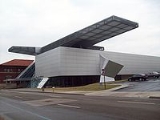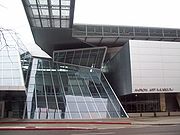
Akron Art Museum
Encyclopedia
The Akron Art Museum is an art museum in Akron
, Ohio
, USA.
The museum first opened its doors on February 1, 1922, as the Akron Art Institute. It was located in two borrowed rooms in the basement of the public library. The Institute offered classes in arts appreciation and has grown considerably since that time, 20000 square feet (1,858.1 m²) of gallery space dedicated to the display of its collection of art produced since 1850. The new museum was open to the public on July 17, 2007, and hosts visiting shows from national and international collections.
Western art created between 1850 and 1950 graces the first floor of the museum’s 1899 Italian Renaissance
revival style building. The first two rooms feature examples of turn-of-the-century realism and American impressionism
. Two rooms explore modernism
and regionalism in northeast Ohio from 1910 through 1950. A final room is dedicated entirely to the work of William Sommer
, a northeast Ohio artist. These galleries include paintings by Thomas Wilmer Dewing and Frederick Carl Frieseke
.
 1950 to Now
1950 to Now
Art since 1950 is featured in eight rooms located in the museum’s 2007 Knight building. These galleries reflect the eclectic style of late twentieth-century art through examples of postmodern painting and sculpture, photorealism
and Pop Art
. On view are Chuck Close
’s Linda, an oversize early painting; Andy Warhol
’s silk-screened Single Elvis and Brillo Boxes; and Ohio carver and preacher Elijah Pierce’s animated relief sculpture The Wise and Foolish Virgins and Four Other Scenes.
, and shows organized by the museum, such as A Shared Vision: The Fred and Laura Ruth Bidwell Photography Collection. The museum also features more than 2000 square feet (185.8 m²) used for intimate exhibitions of emerging or mid-career artists, community-based art projects and changing exhibitions of photographic media.
 The 63000 square feet (5,852.9 m²) John S. and James L. Knight Building was designed by the Viennese architectural firm Coop Himmelb(l)au
The 63000 square feet (5,852.9 m²) John S. and James L. Knight Building was designed by the Viennese architectural firm Coop Himmelb(l)au
following an international competition. The firm was chosen in part for its adaptive use of historic buildings, and the Knight Building is the firm’s first project in the Americas. Ground breaking for the new building was held on May 22, 2004.
Coop Himmelb(l)au
’s design integrates additional gallery space, an auditorium and café with the museum’s 1899 building utilizing contrasting, surprising and fanciful visual elements:
The “Crystal”, a three-story glass lobby that serves as the public entry and as the focal visual space connecting the museum’s artistic, educational, administrative, and public programming; the “Gallery Box”, comprising the Arnstein, Haslinger, Bidwell and Isroff Galleries, accommodates the museum’s collection and temporary exhibitions; and the “Roof Cloud”, a 327 feet (99.7 m)-long cantilevered steel and aluminum armature extends over the old and the new, creating a striking landmark for Akron’s downtown which a critic once described as "a mechanical alligator snarfing down a Beaux Arts post office."
The expansion dramatically increased the museum’s ability to present traveling exhibitions and to organize its own distinctive exhibitions. The expansion also allows for the display of major, rarely-seen works, including Elliot Torrey’s Surf, the first work to enter the Akron Art Institute’s collection in 1923.
“The design embraces the past, rather than replacing or destroying it”, said Coop Himmelb(l)au
founder, and principal architect for the project, Wolf D. Prix. “It uses architecture to create a public space within the city and a private space within our own souls-reinventing both the city and ourselves at the same time. With such a project, there is a great opportunity to make a living contribution to a city.”
Akron, Ohio
Akron , is the fifth largest city in the U.S. state of Ohio and the county seat of Summit County. It is located in the Great Lakes region approximately south of Lake Erie along the Little Cuyahoga River. As of the 2010 census, the city had a population of 199,110. The Akron Metropolitan...
, Ohio
Ohio
Ohio is a Midwestern state in the United States. The 34th largest state by area in the U.S.,it is the 7th‑most populous with over 11.5 million residents, containing several major American cities and seven metropolitan areas with populations of 500,000 or more.The state's capital is Columbus...
, USA.
The museum first opened its doors on February 1, 1922, as the Akron Art Institute. It was located in two borrowed rooms in the basement of the public library. The Institute offered classes in arts appreciation and has grown considerably since that time, 20000 square feet (1,858.1 m²) of gallery space dedicated to the display of its collection of art produced since 1850. The new museum was open to the public on July 17, 2007, and hosts visiting shows from national and international collections.
Collections
1850-1950Western art created between 1850 and 1950 graces the first floor of the museum’s 1899 Italian Renaissance
Italian Renaissance
The Italian Renaissance began the opening phase of the Renaissance, a period of great cultural change and achievement in Europe that spanned the period from the end of the 13th century to about 1600, marking the transition between Medieval and Early Modern Europe...
revival style building. The first two rooms feature examples of turn-of-the-century realism and American impressionism
Impressionism
Impressionism was a 19th-century art movement that originated with a group of Paris-based artists whose independent exhibitions brought them to prominence during the 1870s and 1880s...
. Two rooms explore modernism
Modernism
Modernism, in its broadest definition, is modern thought, character, or practice. More specifically, the term describes the modernist movement, its set of cultural tendencies and array of associated cultural movements, originally arising from wide-scale and far-reaching changes to Western society...
and regionalism in northeast Ohio from 1910 through 1950. A final room is dedicated entirely to the work of William Sommer
William Sommer
William Sommer was an American Modernist painter.William Sommer was born in Detroit, Michigan in 1867. He was largely self-taught, but received instruction early on from artist and commercial lithographer Julius Melchers...
, a northeast Ohio artist. These galleries include paintings by Thomas Wilmer Dewing and Frederick Carl Frieseke
Frederick Carl Frieseke
Frederick Carl Frieseke was an American Impressionist painter who spent most of his life as an expatriate in France. An influential member of the Giverny art colony, his paintings often concentrated on various effects of dappled sunlight...
.

Art since 1950 is featured in eight rooms located in the museum’s 2007 Knight building. These galleries reflect the eclectic style of late twentieth-century art through examples of postmodern painting and sculpture, photorealism
Photorealism
Photorealism is the genre of painting based on using the camera and photographs to gather information and then from this information creating a painting that appears photographic...
and Pop Art
Pop art
Pop art is an art movement that emerged in the mid 1950s in Britain and in the late 1950s in the United States. Pop art challenged tradition by asserting that an artist's use of the mass-produced visual commodities of popular culture is contiguous with the perspective of fine art...
. On view are Chuck Close
Chuck Close
Charles Thomas "Chuck" Close is an American painter and photographer who achieved fame as a photorealist, through his massive-scale portraits...
’s Linda, an oversize early painting; Andy Warhol
Andy Warhol
Andrew Warhola , known as Andy Warhol, was an American painter, printmaker, and filmmaker who was a leading figure in the visual art movement known as pop art...
’s silk-screened Single Elvis and Brillo Boxes; and Ohio carver and preacher Elijah Pierce’s animated relief sculpture The Wise and Foolish Virgins and Four Other Scenes.
Temporary exhibitions
Major temporary exhibitions are housed on the second floor of the Knight Building. These exhibitions include traveling shows, such as American Chronicles: The Art of Norman RockwellNorman Rockwell
Norman Percevel Rockwell was a 20th-century American painter and illustrator. His works enjoy a broad popular appeal in the United States for their reflection of American culture. Rockwell is most famous for the cover illustrations of everyday life scenarios he created for The Saturday Evening...
, and shows organized by the museum, such as A Shared Vision: The Fred and Laura Ruth Bidwell Photography Collection. The museum also features more than 2000 square feet (185.8 m²) used for intimate exhibitions of emerging or mid-career artists, community-based art projects and changing exhibitions of photographic media.
Knight Building

Coop Himmelb(l)au
Coop Himmelbau is a cooperative architectural design firm primarily located in Vienna, Austria and which now also maintains offices in Los Angeles, United States and Guadalajara, Mexico...
following an international competition. The firm was chosen in part for its adaptive use of historic buildings, and the Knight Building is the firm’s first project in the Americas. Ground breaking for the new building was held on May 22, 2004.
Coop Himmelb(l)au
Coop Himmelb(l)au
Coop Himmelbau is a cooperative architectural design firm primarily located in Vienna, Austria and which now also maintains offices in Los Angeles, United States and Guadalajara, Mexico...
’s design integrates additional gallery space, an auditorium and café with the museum’s 1899 building utilizing contrasting, surprising and fanciful visual elements:
The “Crystal”, a three-story glass lobby that serves as the public entry and as the focal visual space connecting the museum’s artistic, educational, administrative, and public programming; the “Gallery Box”, comprising the Arnstein, Haslinger, Bidwell and Isroff Galleries, accommodates the museum’s collection and temporary exhibitions; and the “Roof Cloud”, a 327 feet (99.7 m)-long cantilevered steel and aluminum armature extends over the old and the new, creating a striking landmark for Akron’s downtown which a critic once described as "a mechanical alligator snarfing down a Beaux Arts post office."
The expansion dramatically increased the museum’s ability to present traveling exhibitions and to organize its own distinctive exhibitions. The expansion also allows for the display of major, rarely-seen works, including Elliot Torrey’s Surf, the first work to enter the Akron Art Institute’s collection in 1923.
“The design embraces the past, rather than replacing or destroying it”, said Coop Himmelb(l)au
Coop Himmelb(l)au
Coop Himmelbau is a cooperative architectural design firm primarily located in Vienna, Austria and which now also maintains offices in Los Angeles, United States and Guadalajara, Mexico...
founder, and principal architect for the project, Wolf D. Prix. “It uses architecture to create a public space within the city and a private space within our own souls-reinventing both the city and ourselves at the same time. With such a project, there is a great opportunity to make a living contribution to a city.”

